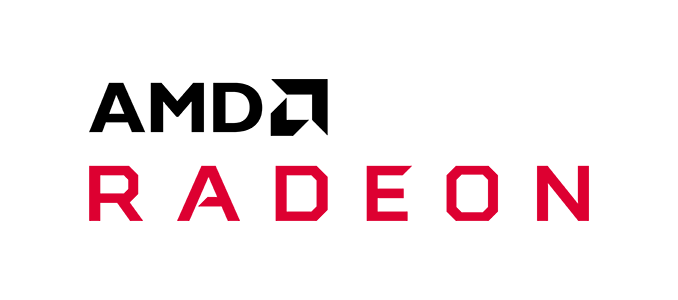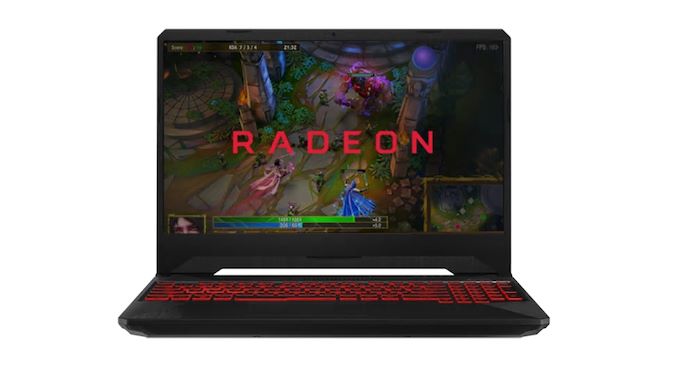AMD Quietly Releases Low-End OEM Radeon 600 Series: Radeon Rebadge 2019
by Ryan Smith on August 13, 2019 1:30 PM EST
While AMD’s focus with the launch of their Radeon RX 5000 series “Navi” product stack has been on midrange desktop cards – and rightfully so – it’s not the only market AMD serves. For as much as the company gets to set their own cadence in hardware design cycles, when it comes to hardware release cycles the company still needs to move to the beat of their single biggest customers: the OEMs. And with the OEMs being driven by market trends and seasonal, cyclical matters, OEMs have historically asked for new hardware between actual design cycles.
To that end, today AMD has quietly announced a new generation of products (of sorts), the Radeon 600 series. Aimed at the low-end of the market – and primarily laptops at that – the Radeon 600 parts are a pure rebadge of AMD’s existing 500 series parts, and are designed to flesh out the very bottom of AMD’s product stack. As is typical for low-end parts, these entries are based on a mix of existing AMD GPUs, using Polaris 12/23, GCN 3 “Topaz”, and GCN 1 “Oland” GPUs depending on the performance class.
Overall, this segment of the market is at the very tail end of AMD’s product stack. So low, in fact, that this is the segment where AMD doesn’t even produce new GPUs, as this is where higher-end integrated GPUs take over and the demand isn’t there for super small discrete GPUs. Hence the hodge-podge mix of GPUs; it’s essentially a collection of AMD’s lowest-end GPUs from a few generations, for the specific customers that need them.
As for the rebadging, this is a semi-annual event driven by OEM product cycles. In short, with the shorter product cycles of OEM systems versus retail channel video cards, OEMs want to advertise the latest components when they refresh and update their systems, even when new GPUs are not available. To which NVIDIA and AMD rebrand, refresh, or otherwise re-designate existing SKUs as new OEM-exclusive parts.
| AMD OEM Desktop & Mobile Radeon 600 Series | ||||||||
| Radeon RX 640 |
Radeon 630 |
Radeon 625 | Radeon 620 | Radeon 610 | ||||
| Base Model | Radeon 550X |
Radeon 540X |
Radeon 535 | Radeon 530 | Radeon 520 | |||
| Compute Units | 10 (640 SP) |
8 (512 SP) |
8 (512 SP) |
6 (384 SP) |
6 (384 SP) |
5 (320 SP) |
||
| Texture Units | 40 | 32 | 32 | 24 | 24 | 20 | ||
| ROPs | 16 | 8 | 8 | 8 | 4 | |||
| Boost Clock (up to) | <= 1287MHz | <= 1219MHz | <= 1024MHZ | <= 1024MHz | <= 1030MHz | |||
| Memory Clock | 7 Gbps GDDR5 | 6 Gbps GDDR5 | 4.5 Gbps GDDR5 | 4.5 Gbps GDDR5 or ? Gbps DDR3 |
4.5 Gbps GDDR5 | |||
| Memory Bus Width | 64-bit | 64-bit | 64-bit | 64-bit | 64-bit | |||
| VRAM | 2GB/4GB | |||||||
| Transistor Count | 2.2B | 3.3B | 1B | |||||
| GPU | Polaris 12/23 | Topaz | Oland? | |||||
| Process | GlobalFoundries 14nm | TSMC 28nm | ||||||
| Architecture | GCN 4 | GCN 3 | GCN 1 | |||||
| Listed Segment(s) | Desktop Laptop |
Desktop Laptop |
Laptop | Laptop | Laptop | |||
| Launch Date | 08/13/2019 | |||||||
Looking at the parts themselves, there’s not a ton to say here. At the top of the new Radeon 600 series is the Radeon RX 640, which is the only part to get an RX designation. Based on the specs, this would be a Polaris 12/23 part, which is AMD’s smallest GCN 4 GPU. The specs are line-for-line identical to the Radeon 550X, so AMD has not made any changes here. Overall, this part uses cut-down versions of the underlying Polaris GPU, with a mix of 8 CU and 10 CU versions. More notably, half of the memory bus has been lopped off, leaving just a 64-bit memory bus that’s running 7Gbps GDDR5.
Below the Radeon RX 640 is the Radeon 630. This appears to be another Polaris 12/23 part, this time recycling the Radeon 540X. Relative to the fastest part in the stack, this only comes with 8 CUs, and half of the ROPs have been disabled, leaving 8. Memory bandwidth has also been cut down a bit as well, dropping down to 6Gbps.
Past this, we have the Radeon 625, Radeon 620, and Radeon 610. While AMD’s website currently lists these are all being GCN 4 parts, the specifications are actually a perfect match for the Radeon 535, 530, and 520 respectively. Which is to say we’re looking at GCN 3 “Topaz” for the first two parts, and, refusing to die, GCN 1 “Oland” for the Radeon 610. These parts come with 6 or fewer CUs, with maximum clockspeeds at 1030Mhz or lower. Depending on the part, these come with 4.5Gbps GDDR5, or DDR3. Notably, none of the parts here have video decoders; they are meant to be entry-level parts for improving GPU performance in laptops, relying on the integrated GPU for video duties.
Overall, the release of the Radeon 600 appears to be timed to coincide with the launch of Intel’s 10th generation Core CPUs, which will begin showing up in laptops in September. While I don’t expect we’ll see these AMD parts paired with Intel’s latest wares – which tend towards the high-end – the launch of the 10th gen Core series is triggering a complete cascade of laptop family refreshes as the OEMs redo their product stacks. To that end, while AMD’s share of the laptop GPU market is relatively small, they still remain a common sight thanks to Radeon parts such as these.
Source: AMD











27 Comments
View All Comments
PeachNCream - Tuesday, August 13, 2019 - link
I have peered into the barrel and have seen what resides at the bottom. I go away impressed at how well AMD can scrape at it during the annual rebadge effort. 64-bit GDDR5 is bad enough, I really hope there isn't a 64-bit DDR3 version. That'd be in the neighborhood of 14 GB/s of video memory bandwidth. I've been there a number of years ago and it was an unhappy place.Alistair - Tuesday, August 13, 2019 - link
There's a large national computer parts chain store near where I live and they charge the same amount of money for the RX 550 and 560 as the 570, so no one buys anything except the 570. All these "video cards" are so low end no one carries them anyways, oem only. Would be nice to see a 10 CU unit Navi part to completely replace every one of these cards, as they are all pointless and basically cost the same to manufacture as a 10 CU part anyways.Smell This - Tuesday, August 13, 2019 - link
Yeah . . . No
This is the *Lexa* variant at 103mm2 or roughly 600 per wafer. It uses the GCN 4.0 arch, has UVD 6.x, 50w (or less), and is 'highly binned' for desktop, mobile and an entry-level pro card. The Polaris XL or '570' is 232 mm²
The AMD Raven Ridge Ryzen APUs with Vega graphics have 'Unified Video Decoder' 7.2 (or, 'Video Core Next' - VCN 1.0) NOT to be confused with the 7nm Radeon Instinct pro cards (and 'VII' desktop) with UVD 7.2/VCN 1.0 Vega.
It was tough going to UVD from Avivo, and now 'VCN.' The next-gen Navi 'Lite' APU at 7nm/Zen2 with the new 'VCN 2.0' will likely arrive in Q2-20 . . .
on a chiplet ;-)
Alistair - Tuesday, August 13, 2019 - link
I have no idea what you are trying to say. A 10 CU Navi part would be 70-80mm2 or so, a very cheap and low end GPU that should replace all these useless outdated products imo. $99 or less.StevoLincolnite - Tuesday, August 13, 2019 - link
A 64-bit GDDR5 Radeon 630 would probably be a step up over Vega 10 in Ryzen 2700u/3700u notebooks too... Those parts tend to be bandwidth starved on dual-channel DDR4 2400mhz.Boy 28nm is getting long in the tooth though.
Dragonstongue - Wednesday, August 14, 2019 - link
at least is VERY well known, likely extremely great yield as well as amazingly low cost to produce (great margins, though have to sell many)Staying on known process has many benefit, ask Intel LMAO
Zoolook13 - Thursday, August 15, 2019 - link
I doubt they can do that, they need every wafer on 7nm they can get out of Tsmc to fill the channel with EPYC and Ryzen right now, I'd say Navi is probably secondary for the moment.AMD makes much more money / wafer on chiplets that can go into EPYC's and judging from the reception they will be able to sell every part they can produce for a long time.
I wouldn't be surprised if the availability of 5700 and 5700XT will be scarce for a while.
Lonyo - Friday, August 16, 2019 - link
If the price of the wafer increases by more than the die size saving from a new process, a small old-tech refresh costs more than making a similar spec part on the old process. Especially when you don't have to do any design/etc work since it already exists.Wafers are getting expensive at a high rate.
Skeptical123 - Tuesday, August 13, 2019 - link
" a 10 CU unit Navi part to completely replace every one of these cards" I completely agree. Of course it's a safe bet that will be the case in a few years unless we get common enough "igpus" that kill of this market segment. I assume AMD design/manufacturing is not flexible enough nor a strong will to do so at the moment. (Though I assume oem will keep it around a while longer than needed because its easier to up sell two sprite things than charging extra from a random spec on cpu spec sheet for the layperson)Dragonstongue - Wednesday, August 14, 2019 - link
Amen to that, for those like me waiting and sitting on older stuff and want MORE than what RX 57/80 offer up, but not wanting to shell out the nasty pricing as they are.something with 256bit (or even 192) but so little chance of mem bottleneck (as would run out of "horsepower" first) with as you mentioned something along line of a tuned/cut down Vega/Navi frankenstein (why the hell not)
The performance and pricing gap between acceptable "at the moment" and "will be for near future" is quite large, unacceptably so, we should not really be relying on use/3rd hand sales just to get "ok price" on things that really are costing under $100 per unit (many times, much less)
just to rinse and repeat a short time later, because of way they "force" business practise, though I see In/Nv doing so, far more "despicably"
anyways...64bit "needs to die" unless is soldered on mobo only, beyond that, minimum 128bit or higher minimum as otherwise they end up getting trash performance for many "mundane things" as well as more often than should be, the AIB or at least the sellers jack the price of them beyond the pre-determined "cannot be higher than this price point"